Audi in China: Pioneering spirit that has lasted for decades
missing translation: fa.article-intro.reading-time
missing translation: fa.article-intro.reading-time
-1.jpg)
-1.jpg)
Audi A6 Avant e‑tron: electric power consumption (combined): 17.5–14.4 kWh/100 km; CO₂ emissions (combined): 0 g/km; CO₂ class: A.
Audi A6 Avant e‑tron: electric power consumption (combined): 17.5–14.4 kWh/100 km; CO₂ emissions (combined): 0 g/km; CO₂ class: A.
With a host of new models and innovative technologies unveiled in 2024, Audi clearly demonstrated what goal the company is pursuing: unique products and uncompromising quality. At the same time, Audi is undergoing the most significant transformation in its history. With the Audi Agenda, the Board of Management team has taken important steps to ensure the company’s success into the future. Following the program’s initial successes in 2024, the focus will be firmly on its implementation in 2025.
Innovative and inspiring vehicles are one of the four pillars of the Audi Agenda. The transformation and strategy program launched by the Board of Management in 2023 supports the entire Audi team in tackling important issues in the short and long term: The Audi Agenda centers on products, technologies, the brand and the core markets of North America and China. “Audi is undergoing the largest transformation in its history,” says Audi CEO Gernot Döllner. “With the Audi Agenda, we began this transformation in good time and are pressing ahead at speed with its implementation.”
The Audi Agenda
With the Audi Agenda, the company is focusing on what is important for customers: product, technology and brand. While that applies worldwide, the priorities for the core markets of Europe, China and North America differ. In Europe, the company wants to consolidate its established position among premium competitors. As regards China, Audi has positioned itself strongly with the partner companies SAIC and FAW, and is working with other partners on the ground to develop vehicles and functions specifically for customers locally. On the North American market, Audi wants to benefit in coming years from the numerous model launches and is currently looking into further localization options. The Audi Agenda serves as the roadmap here for the entire Audi team and addresses challenges in the short and long term. Specific work packages and responsibilities have been defined for each field of action. And there are already signs of success: The world premiere of the Audi Q6 e‑tron in March 2024 marked the start of the largest model initiative in the company’s history.
Sustainability is also playing an increasingly important role in this context. “We want customers to experience this in our vehicles: with an electrified portfolio, efficient and high-performance drive systems, powerful batteries and practical charging performance.” Audi is also looking beyond the utilization phase. For example, the circularity of the materials used and the subsequent recyclability of vehicle parts are already being considered in the first vehicle projects as early as the development stage.
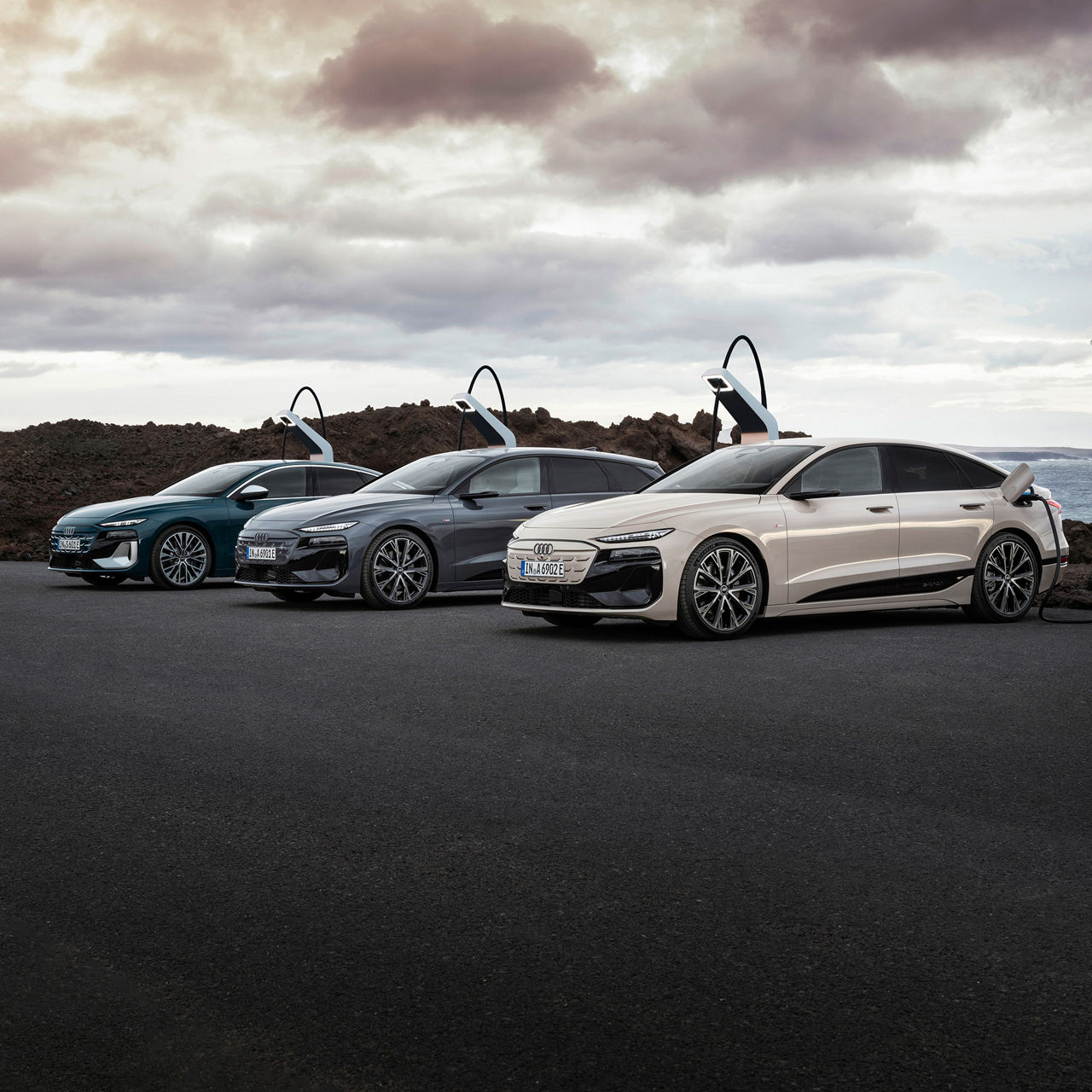
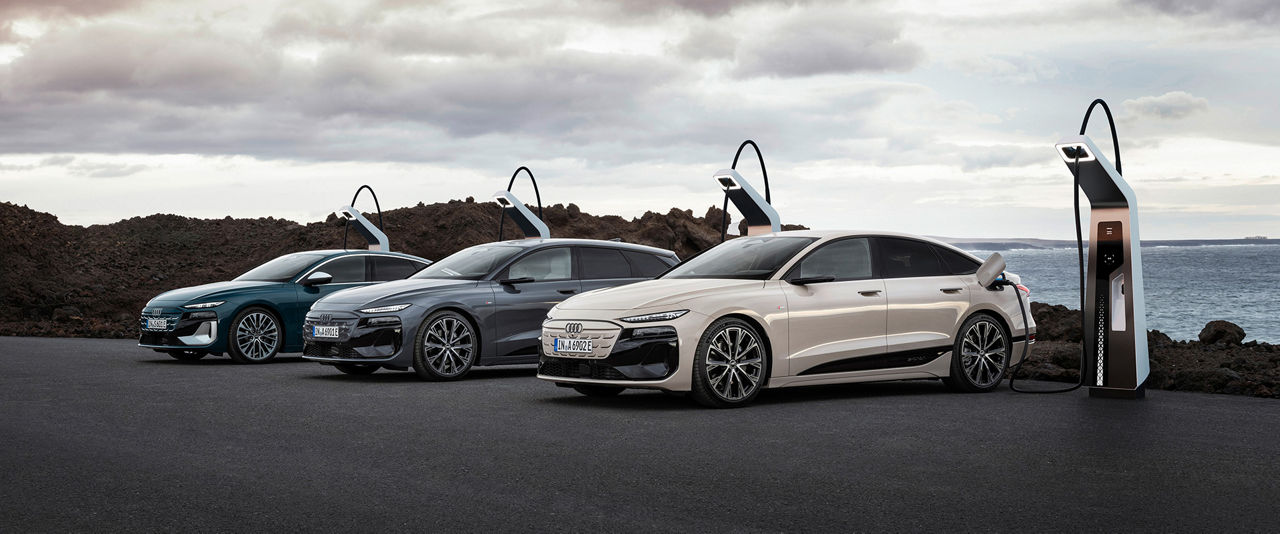
As the second model family based on the Premium Platform Electric (PPE), all variants of the Audi A6 e‑tron draw on the familiar product strengths of the PPE in terms of performance, range, efficiency and charging: Audi A6 Sportback e‑tron performance,* Audi A6 Avant e‑tron performance* and Audi S6 Sportback e‑tron* (from right to left).
As the second model family based on the Premium Platform Electric (PPE), all variants of the Audi A6 e‑tron draw on the familiar product strengths of the PPE in terms of performance, range, efficiency and charging: Audi A6 Sportback e‑tron performance,* Audi A6 Avant e‑tron performance* and Audi S6 Sportback e‑tron* (from right to left).
The new Audi A6 Sportback e‑tron* is a prime example of future Audi models. Its design not only highlights the progressive brand image, it also boosts efficiency. With its exceptionally low drag coefficient of 0.21, the Audi A6 Sportback e‑tron* is, in terms of aerodynamics, the best Audi of all time and currently the best vehicle in the Volkswagen Group. This also makes it incredibly efficient. With a range of up to 756 kilometers (WLTP), the Audi A6 Sportback e‑tron performance* is the strongest model in its segment in this discipline. This is also accounted for by the high-performance and highly efficient electric motors, a newly developed, lighter and especially powerful high-voltage battery, the improved ability to recuperate energy and the powerful charging performance. The sophisticated thermal management of the high-voltage battery, the 800-volt electrical system and its ecosystem ensure a charging performance suitable for everyday use.
Technical innovations in areas such as performance, charging and digitalization are thanks, among other reasons, to the new Premium Platform Electric (PPE). Developed specifically for electric models, its architecture allows for use of a flat-shaped battery and therefore ideally fulfills requirements for an especially sporty design. A completely new drive system and a new, powerful and modular high-voltage battery were developed for the PPE. The vehicle platform offers a great deal of flexibility so that both low-floor models, such as the Audi A6 e‑tron, and high-floor models, such as the Audi Q6 e‑tron, are possible in the midsize and full-size segments. The platform strategy enables Audi to offer innovative products and leverage synergies at the same time. This means that the company can focus to a greater extent on the product features that set Audi apart, including progressive design and premium handling characteristics.
In March 2024, the Audi Q6 e‑tron was the first high-floor model based on the PPE to be unveiled by Audi. The Audi A6 e‑tron and Audi Q6 e‑tron models not only share the same vehicle architecture, they also have the same electronics architecture (E³ 1.2).
This completely new architecture is scalable and used by several brands in the Volkswagen Group. The individual software components were customized by Audi for each specific model. The core elements of the new E³ 1.2 are five high-performance computers, which cover all vehicle functions – from the drive and assist systems to the infotainment and convenience systems through to the safety systems and backend networking. All five computers are designed to accommodate future functional and system enhancements. In addition, the new electronics architecture is equipped for future over-the-air updates.
Among other features, the E³ 1.2 offers a fully connected digital interior. For example, a learning intelligent voice assistant (Audi assistant*) in Audi A6 e‑tron models can control a large number of vehicle functions, learn from the driver’s behavior and actions and make predictive suggestions adapted to the situation. The Audi assistant* is augmented by the integrated ChatGPT function,* which can read content while driving and allows interaction with the car in natural language.
Gernot Döllner, Chairman of the Board of Management of AUDI AG
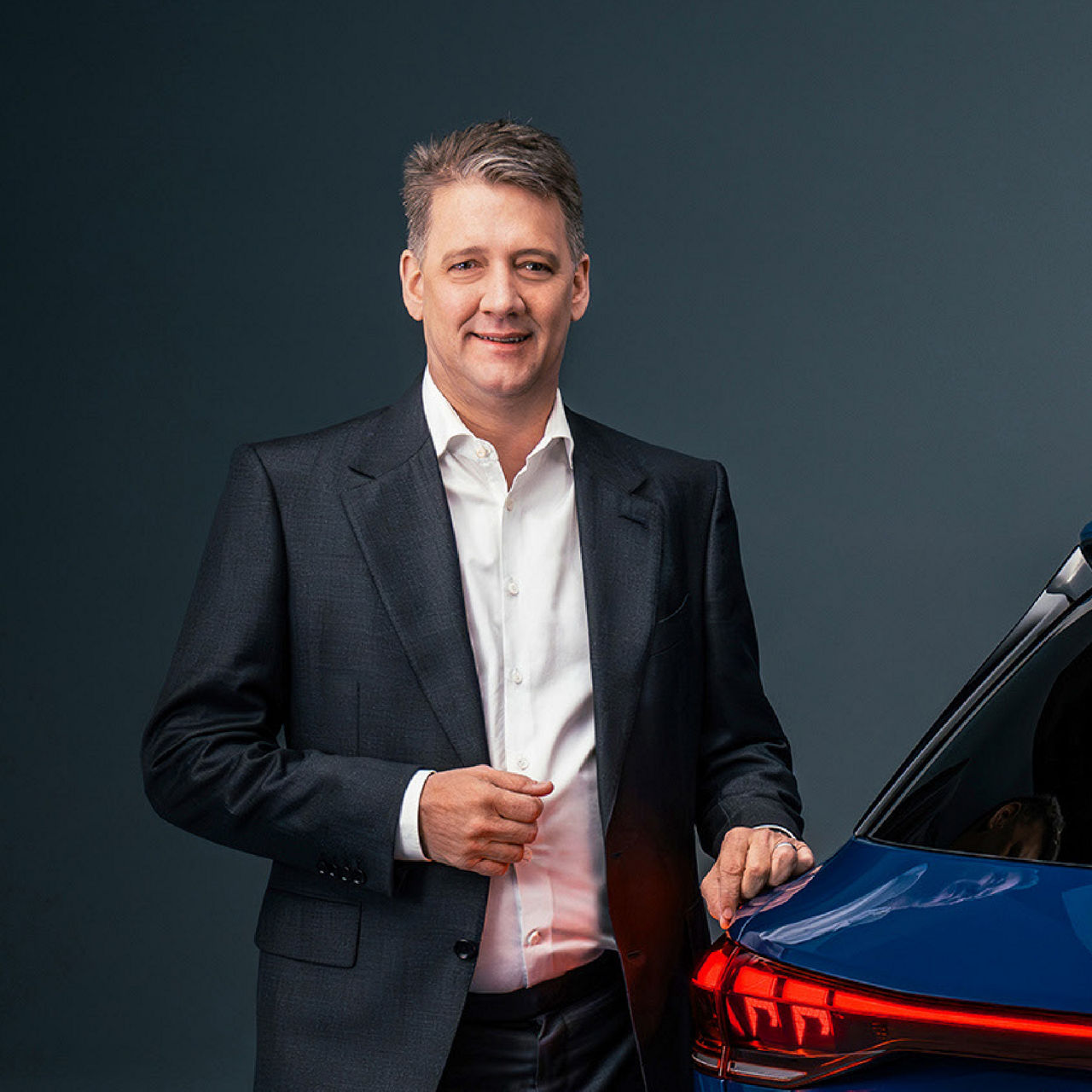
In addition to extending the all-electric portfolio, Audi is launching a new generation of models with efficient combustion engines. The Audi A5 family in the Sedan and Avant body styles were the first models to be presented in July 2024. They dazzled the trade press with their “impressive performance and optimized handling”.* The new Audi Q5 models made their debut later in the year, while the new Audi A6 Avant* is set to premiere in March 2025.
The new combustion engine models are based on the Premium Platform Combustion (PPC). What sets them apart is the exceptional driving pleasure and a technologically advanced drive system. The partly electrified, enhanced mild hybrid powertrains improve responsiveness and enable partially electric driving, for example, when maneuvering into a parking space. This reduces CO₂ emissions. Plug-in hybrids will be added to the Audi A5 and Audi Q5 family in 2025. The Audi A3, Audi Q7 and Audi Q8 were already presented as plug-in hybrids in 2024.
Audi will continue to expand the fully electric model range in parallel. The company already had 10 ten all-electric models in its portfolio in 2024, six of which were presented in this year alone. As well as the Audi A6 e‑tron and Audi Q6 e‑tron family, these include new Audi e‑tron GT models. CEO Döllner confirms: “We are continuing to work consistently on electrifying our model range.” He adds: “By the end of 2025, we will have tackled the largest model initiative in the history of Audi and then have the youngest portfolio in our competitive segment.”
At the same time, the company is facing increasingly volatile customer demand for BEV models and intense competition in many markets. As further electric models are introduced, the company is anticipating that BEV models will make up an additional portion of vehicle sales. Nonetheless, Audi is still in a transition period and therefore remains flexible in the medium term as regards its powertrain strategy. This means that the response to different customer requirements and regulatory constraints will vary on a regional basis and that production of the last combustion engine models will be managed in line with global market trends. “We continue to offer our customers highly competitive combustion engine and electric models,” summarizes Döllner.
The company laid important groundwork for future Audi models in 2024. The focal point will be all-electric low-floor and high-floor models in the core Audi midsize and full-size segments. In addition, Audi plans to launch iconic models on the market – cars that drive “Vorsprung durch Technik” to new highs, are unique in their segment and will also remain desirable for a long time. As was the case in the past with the Audi R8, the Audi TT or currently with the Audi RS e‑tron GT.* The next icon will be an electric entry-level model in the A segment with impressive efficiency. “Regardless of the model, emotional design, quality, sporty performance, driving dynamics and comfort as well as a digital customer experience – this is what sets an Audi apart,” says Gernot Döllner.
Brand core: technology that impresses
Audi needs a strong brand in addition to an attractive product portfolio. For Audi, “Vorsprung durch Technik” means challenging the status quo with inspiring technologies. This can also be seen in the world of motorsport: Audi won the legendary Dakar Rally with the Audi RS Q e‑tron* in early 2024, thus making motorsport history. The racing car combines an electric powertrain with an energy converter system based on the TFSI engine and a generator. It became the first car to win the legendary desert race with this type of drive system.
When Audi joins the top tier of motorsport in 2026, it will face its most challenging task yet in terms of the combination of sustainability, innovation and maximum performance. Formula 1 is a rapidly growing racing series, which offers significant potential for the brand owing to its continued global expansion, huge popularity with fans and the enormous marketing opportunities. During the past year, Audi assembled its factory team for Formula 1, laying the groundwork for future sporting successes.
The transformation toward a manufacturer of all-electric and fully connected vehicles is the most significant change in the company’s history. At the same time, economic conditions are becoming increasingly tough. Competitive pressure and political uncertainty are posing unprecedented challenges for the company. “We can no longer develop and produce cars using the same processes as 20 years ago,” says Döllner. “We therefore must and will make Audi more efficient, more competitive and more resilient for the future.”
Learn more
Already in 2024, the company reduced the number of committees, accelerated processes and began to extensively reorganize corporate structures. The goals are clear: flat hierarchies, clearly defined responsibilities, fewer interfaces, faster decisions. The transformation of Technical Development, the product lines and participating interface partners toward a matrix organization acted as the launching pad for reorganizing all of the divisions. The new collaboration model minimizes interfaces, accelerates decision-making processes and therefore also vehicle development, and promotes innovation.
Audi will continue to stand for emotional design in the future. Responsibility for achieving this was placed in the hands of Massimo Frascella and his team on June 1, 2024. Organizationally too, Audi Design has been strengthened. As a brand-building unit of strategic relevance, it reports directly to the Chairman of the Board of Management.
In parallel, the company initiated further far-reaching changes in 2024. These include the premature end of production of the Audi Q8 e‑tron* and the termination of production in Brussels. Company management and the Works Council began joint negotiations in the year under review to ensure that the German sites are well positioned for the future. These talks focused on content-driven changes to the structural reorganization of the company.*
China market: two partners, twice the strength
The Chinese market is an excellent example of how Audi is upping the pace at present. As early as 1988, Audi demonstrated its pioneering status in China as the first premium automotive brand. In 2024, the company showed its courage once more and its pioneering spirit, when Audi became the first global car manufacturer to launch a premium brand for intelligent and interconnected e-vehicles, specifically tailored to the Chinese premium market. The AUDI sister brand and its first AUDI E concept* showcar debuted at the Guangzhou Motor Show. Positioned in and tailored to China, the brand and the car represent the best of both worlds – the unmistakable Audi DNA combined with innovations from China. The public response was also very positive, with the product launch of the AUDI E concept* proving extremely successful in terms of media reach.
The company is developing further new models under the new sister brand AUDI together with its partner SAIC. Audi deliberately founded the brand in order to tap into younger, tech-savvy Chinese customer groups. The joint venture combines the traditional strengths of Audi in the area of design and driving dynamics with SAIC’s speed of innovation and expertise in China-specific digital features.
The series-production version of the AUDI E concept* is due to be unveiled as early as April 2025 – a midsize model featuring the latest charging technology, a smart cockpit and advanced driver assist systems. It will go on sale in the same year. In collaboration with SAIC, Audi was able to reduce the development time for the model by 30 percent. The company plans to introduce two additional AUDI models in the C segment onto the market within the next two years – an SUV and a Sportback.
Another important milestone in the strategy for the Chinese market: the start of production of the Audi Q6 L e‑tron* family in Changchun in collaboration with First Automotive Works (FAW) at the end of 2024. The new production site is the first in China to exclusively produce fully electric Audi models based on the PPE.
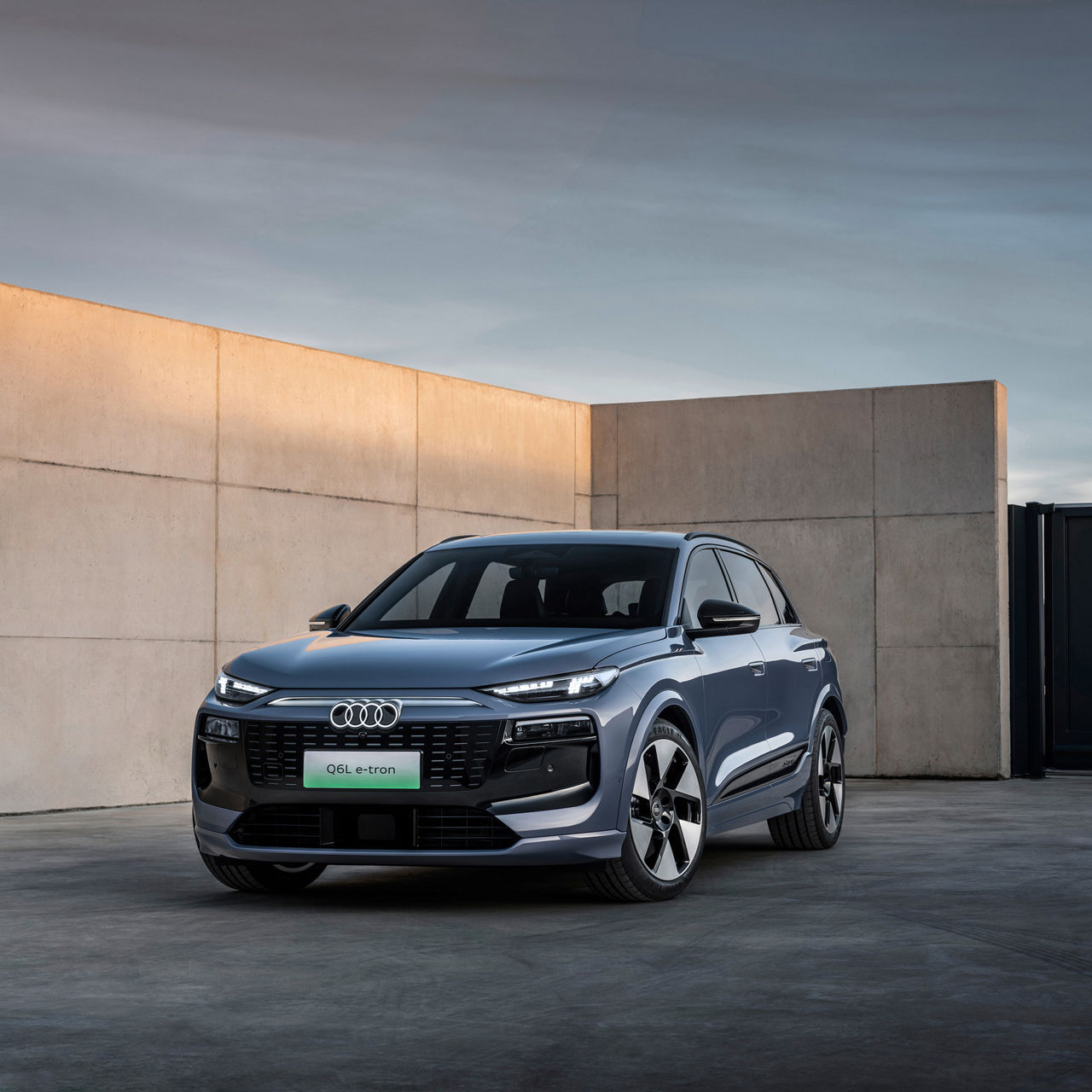
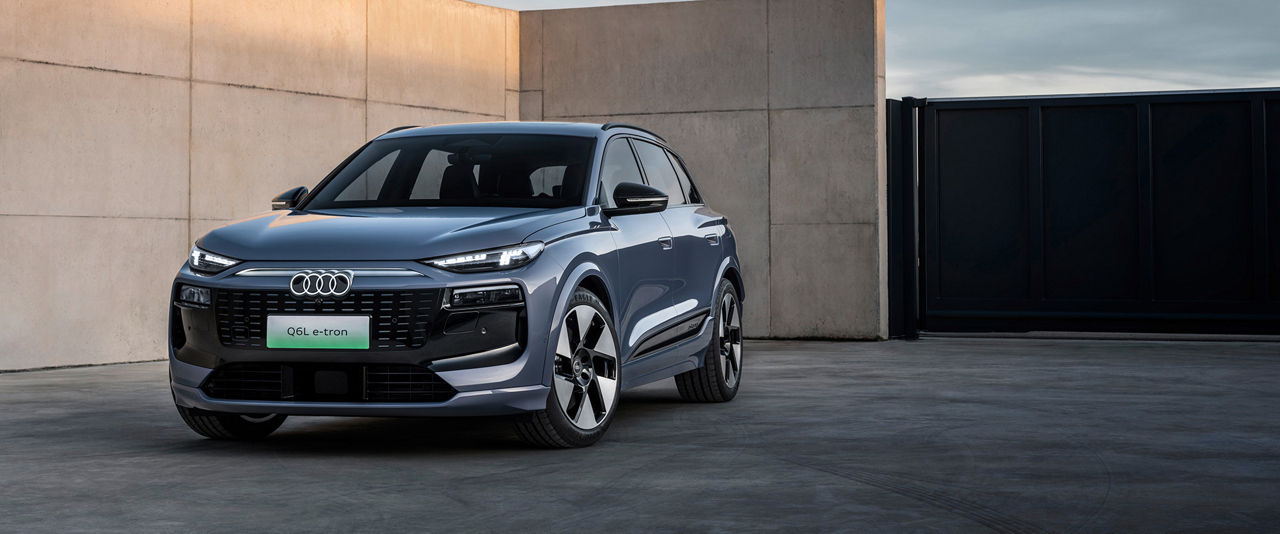
Since the end of December 2024, the Audi Q6 L e‑tron* has been produced exclusively for the Chinese market by Audi FAW NEV Company, a cooperation project between Audi and FAW.
Since the end of December 2024, the Audi Q6 L e‑tron* has been produced exclusively for the Chinese market by Audi FAW NEV Company, a cooperation project between Audi and FAW.
The Audi Q6 L e‑tron family will be the first to roll off the production line here, followed later by a market-specific version of the Audi A6 e‑tron. The new models stand out not only in relation to the traditionally longer wheelbase, but also offer additional design features and digital experiences tailored to Chinese customers. “The start of production in Changchun represents a significant step forward in our electrification strategy. We are therefore upholding our commitment to the Chinese market,” explains Gernot Döllner. “The models produced here will play a crucial role in our local portfolio and strengthen our position in this key market.” With its state-of-the-art, fully digitally integrated and eco-friendly production, the plant is setting new standards across the entire Audi production network, and contributing to Mission:Zero, the global environmental program for all Audi production sites. Production at the plant is planned to be net carbon-neutral* from the beginning with an annual capacity of more than 150,000 vehicles.
US market: foundation laid for future success
Besides China, it is above all the US market that will drive global demand for premium cars for the foreseeable future. Audi is underscoring its commitment in the region of North America and is currently looking into further localization options, including potential for cooperation as part of the Volkswagen Group’s North America strategy – also in areas such as battery production and charging infrastructure. The switch to BEVs presents a unique opportunity in North America. And this opportunity must be seized systematically. Audi is working intensively to set the right strategic course in order to maximize market penetration. Attractive models will be available for customers in the USA in upcoming months with the model families of the Audi A6 e‑tron, Audi Q6 e‑tron, Audi A5, Audi Q5 and Audi A6.
A core element of the Audi Agenda is the systematic acceleration of development work through the introduction of a matrix organization. This involves a paradigm shift toward integral development of vehicles with software as a leading element – so-called software-defined vehicles. The focus is shifting to include software functions in the development process in addition to hardware components such as the body, powertrain and suspension. Software and electronics are set to become the primary drivers of innovation in the future.
Strong partnerships are also an important success factor on the path to the software-defined vehicle (SDV). With the joint venture between the Volkswagen Group and Rivian, Audi now has a clear roadmap for the future. The Volkswagen Group and Rivian are bundling the innovative strength of both companies in the newly founded company and plan to jointly develop a new electronics architecture for the SDV. Rivian’s software and electrical hardware technology complements the global presence and competence of the Volkswagen Group in the area of vehicle platforms. This should reduce development costs and help to scale new technologies faster. The architecture will enable over-the-air updates and offer scalability across all segments. The first cars featuring the new architecture will be introduced onto the market in 2027. Audi is playing a leading role in this respect, with teams from Audi and Rivian having already demonstrated the technological potential of the joint endeavor in the form of a roadworthy demonstration model of the Audi Q6 e‑tron.
The political and overall economic situation along with strong competitive pressure, especially in the core markets of Europe, China and the US, pose major challenges for Audi. At the same time, the company is facing an unprecedented internal transformation. “We are facing the future with confidence,” says Döllner. Courage, pioneering spirit and innovative strength are values that characterize the Audi team. and have already allowed it to celebrate success in 2024. “Our previous achievements give me reason to be confident. Now it’s about staying the course, acting consistently and putting Audi back on top again.”
“With the Audi Agenda, we have defined a clear plan. We are a strong team and are tackling the challenges together.
Gernot Döllner, Chairman of the Board of Management of AUDI AG